Trends in Externalization of Work: Impact on Workers and Management
VerifiedAdded on 2022/10/07
|11
|3303
|20
Essay
AI Summary
This essay examines the increasing trend of externalization of work by organizations globally, focusing on outsourcing, contracting out, part-time work, and casual work arrangements. It addresses the challenges in accessing comparable data on non-standard work due to varying definitions across countries and explores the growing prevalence of these arrangements in regions like North America, Europe, and Australia. The essay discusses different forms of non-standard work, including part-time work, contract work, and outsourcing, highlighting current trends such as the rise of part-time employment, the expansion of contracting services, and the evolution of outsourcing models. It also delves into the implications for workers, such as potential confusion over wages and employment conditions, and for managers, who must navigate complex labor arrangements to maintain flexibility and productivity. The analysis is supported by labor market data and insights from academic literature, providing a comprehensive assessment of the externalization of work and its impact on various stakeholders.
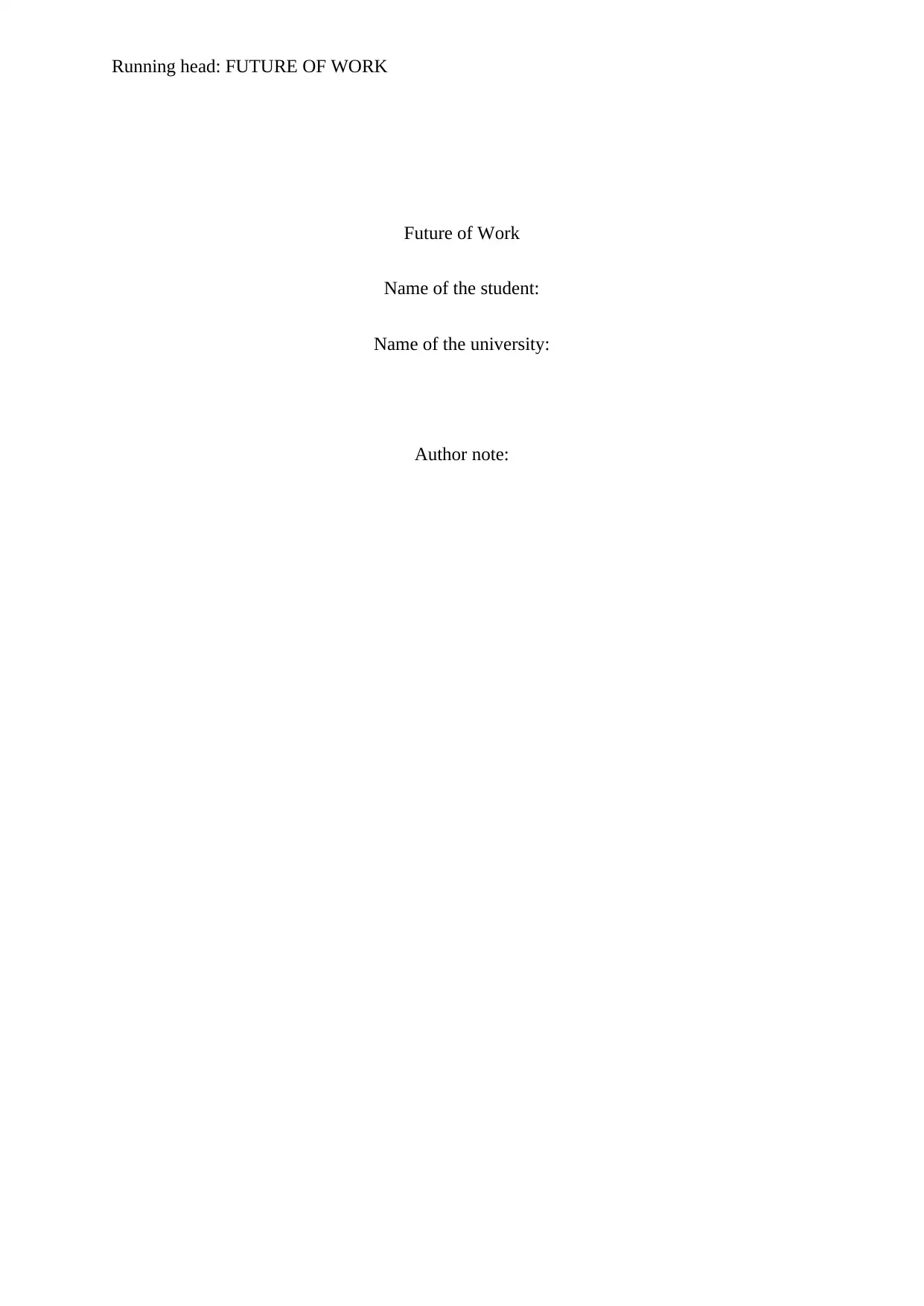
Running head: FUTURE OF WORK
Future of Work
Name of the student:
Name of the university:
Author note:
Future of Work
Name of the student:
Name of the university:
Author note:
Paraphrase This Document
Need a fresh take? Get an instant paraphrase of this document with our AI Paraphraser
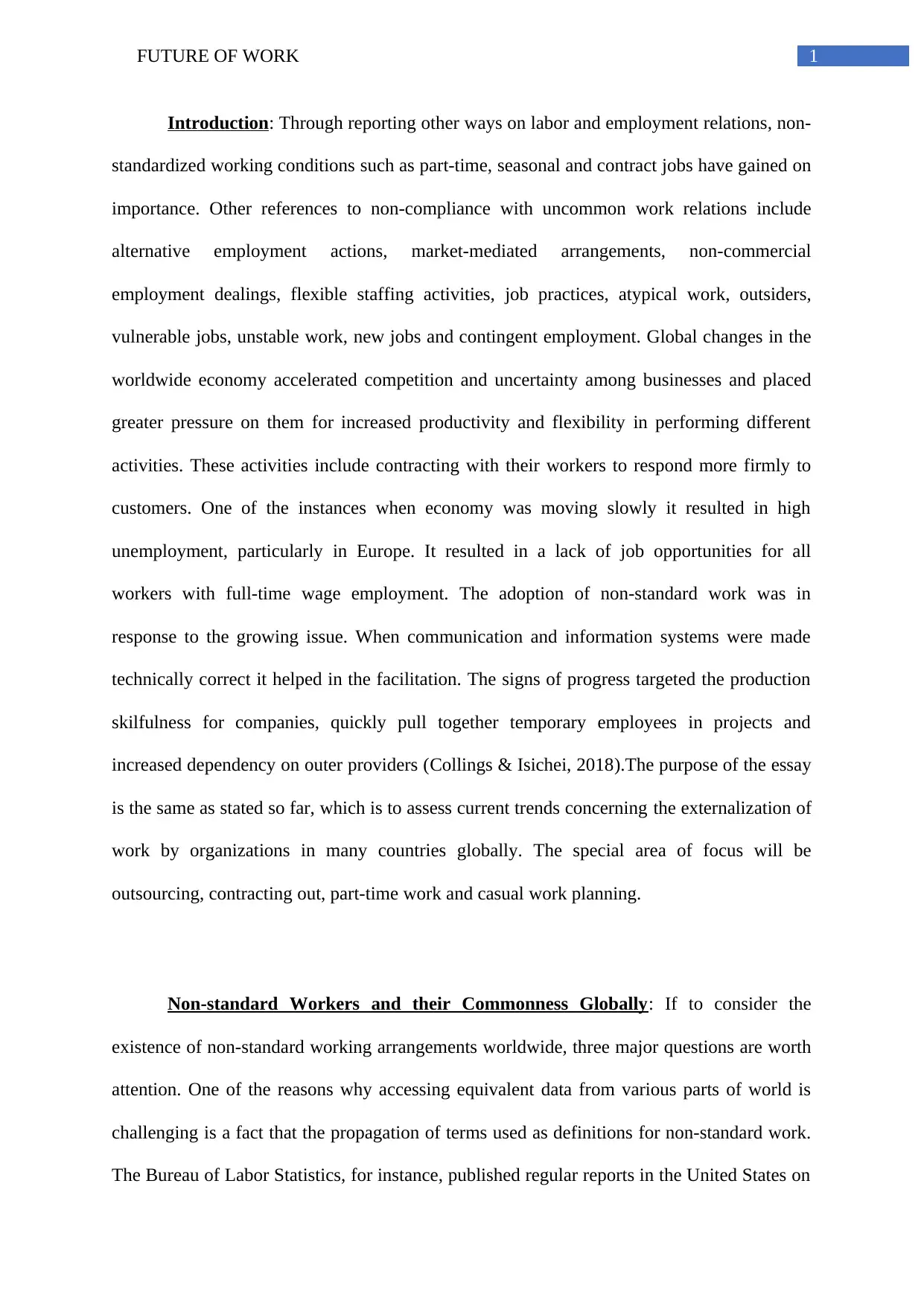
1FUTURE OF WORK
Introduction: Through reporting other ways on labor and employment relations, non-
standardized working conditions such as part-time, seasonal and contract jobs have gained on
importance. Other references to non-compliance with uncommon work relations include
alternative employment actions, market-mediated arrangements, non-commercial
employment dealings, flexible staffing activities, job practices, atypical work, outsiders,
vulnerable jobs, unstable work, new jobs and contingent employment. Global changes in the
worldwide economy accelerated competition and uncertainty among businesses and placed
greater pressure on them for increased productivity and flexibility in performing different
activities. These activities include contracting with their workers to respond more firmly to
customers. One of the instances when economy was moving slowly it resulted in high
unemployment, particularly in Europe. It resulted in a lack of job opportunities for all
workers with full-time wage employment. The adoption of non-standard work was in
response to the growing issue. When communication and information systems were made
technically correct it helped in the facilitation. The signs of progress targeted the production
skilfulness for companies, quickly pull together temporary employees in projects and
increased dependency on outer providers (Collings & Isichei, 2018).The purpose of the essay
is the same as stated so far, which is to assess current trends concerning the externalization of
work by organizations in many countries globally. The special area of focus will be
outsourcing, contracting out, part-time work and casual work planning.
Non-standard Workers and their Commonness Globally: If to consider the
existence of non-standard working arrangements worldwide, three major questions are worth
attention. One of the reasons why accessing equivalent data from various parts of world is
challenging is a fact that the propagation of terms used as definitions for non-standard work.
The Bureau of Labor Statistics, for instance, published regular reports in the United States on
Introduction: Through reporting other ways on labor and employment relations, non-
standardized working conditions such as part-time, seasonal and contract jobs have gained on
importance. Other references to non-compliance with uncommon work relations include
alternative employment actions, market-mediated arrangements, non-commercial
employment dealings, flexible staffing activities, job practices, atypical work, outsiders,
vulnerable jobs, unstable work, new jobs and contingent employment. Global changes in the
worldwide economy accelerated competition and uncertainty among businesses and placed
greater pressure on them for increased productivity and flexibility in performing different
activities. These activities include contracting with their workers to respond more firmly to
customers. One of the instances when economy was moving slowly it resulted in high
unemployment, particularly in Europe. It resulted in a lack of job opportunities for all
workers with full-time wage employment. The adoption of non-standard work was in
response to the growing issue. When communication and information systems were made
technically correct it helped in the facilitation. The signs of progress targeted the production
skilfulness for companies, quickly pull together temporary employees in projects and
increased dependency on outer providers (Collings & Isichei, 2018).The purpose of the essay
is the same as stated so far, which is to assess current trends concerning the externalization of
work by organizations in many countries globally. The special area of focus will be
outsourcing, contracting out, part-time work and casual work planning.
Non-standard Workers and their Commonness Globally: If to consider the
existence of non-standard working arrangements worldwide, three major questions are worth
attention. One of the reasons why accessing equivalent data from various parts of world is
challenging is a fact that the propagation of terms used as definitions for non-standard work.
The Bureau of Labor Statistics, for instance, published regular reports in the United States on
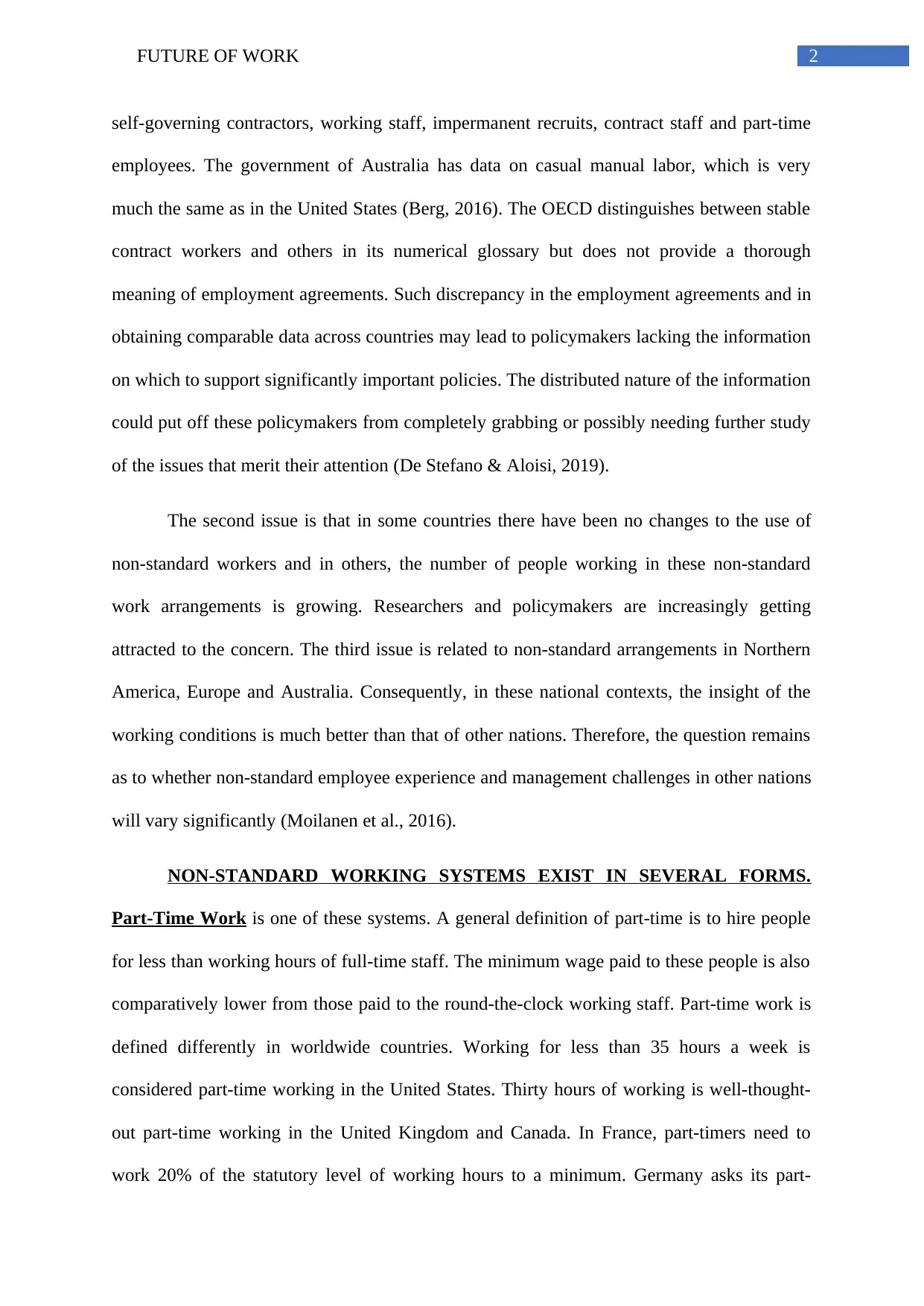
2FUTURE OF WORK
self-governing contractors, working staff, impermanent recruits, contract staff and part-time
employees. The government of Australia has data on casual manual labor, which is very
much the same as in the United States (Berg, 2016). The OECD distinguishes between stable
contract workers and others in its numerical glossary but does not provide a thorough
meaning of employment agreements. Such discrepancy in the employment agreements and in
obtaining comparable data across countries may lead to policymakers lacking the information
on which to support significantly important policies. The distributed nature of the information
could put off these policymakers from completely grabbing or possibly needing further study
of the issues that merit their attention (De Stefano & Aloisi, 2019).
The second issue is that in some countries there have been no changes to the use of
non-standard workers and in others, the number of people working in these non-standard
work arrangements is growing. Researchers and policymakers are increasingly getting
attracted to the concern. The third issue is related to non-standard arrangements in Northern
America, Europe and Australia. Consequently, in these national contexts, the insight of the
working conditions is much better than that of other nations. Therefore, the question remains
as to whether non-standard employee experience and management challenges in other nations
will vary significantly (Moilanen et al., 2016).
NON-STANDARD WORKING SYSTEMS EXIST IN SEVERAL FORMS.
Part-Time Work is one of these systems. A general definition of part-time is to hire people
for less than working hours of full-time staff. The minimum wage paid to these people is also
comparatively lower from those paid to the round-the-clock working staff. Part-time work is
defined differently in worldwide countries. Working for less than 35 hours a week is
considered part-time working in the United States. Thirty hours of working is well-thought-
out part-time working in the United Kingdom and Canada. In France, part-timers need to
work 20% of the statutory level of working hours to a minimum. Germany asks its part-
self-governing contractors, working staff, impermanent recruits, contract staff and part-time
employees. The government of Australia has data on casual manual labor, which is very
much the same as in the United States (Berg, 2016). The OECD distinguishes between stable
contract workers and others in its numerical glossary but does not provide a thorough
meaning of employment agreements. Such discrepancy in the employment agreements and in
obtaining comparable data across countries may lead to policymakers lacking the information
on which to support significantly important policies. The distributed nature of the information
could put off these policymakers from completely grabbing or possibly needing further study
of the issues that merit their attention (De Stefano & Aloisi, 2019).
The second issue is that in some countries there have been no changes to the use of
non-standard workers and in others, the number of people working in these non-standard
work arrangements is growing. Researchers and policymakers are increasingly getting
attracted to the concern. The third issue is related to non-standard arrangements in Northern
America, Europe and Australia. Consequently, in these national contexts, the insight of the
working conditions is much better than that of other nations. Therefore, the question remains
as to whether non-standard employee experience and management challenges in other nations
will vary significantly (Moilanen et al., 2016).
NON-STANDARD WORKING SYSTEMS EXIST IN SEVERAL FORMS.
Part-Time Work is one of these systems. A general definition of part-time is to hire people
for less than working hours of full-time staff. The minimum wage paid to these people is also
comparatively lower from those paid to the round-the-clock working staff. Part-time work is
defined differently in worldwide countries. Working for less than 35 hours a week is
considered part-time working in the United States. Thirty hours of working is well-thought-
out part-time working in the United Kingdom and Canada. In France, part-timers need to
work 20% of the statutory level of working hours to a minimum. Germany asks its part-
⊘ This is a preview!⊘
Do you want full access?
Subscribe today to unlock all pages.

Trusted by 1+ million students worldwide
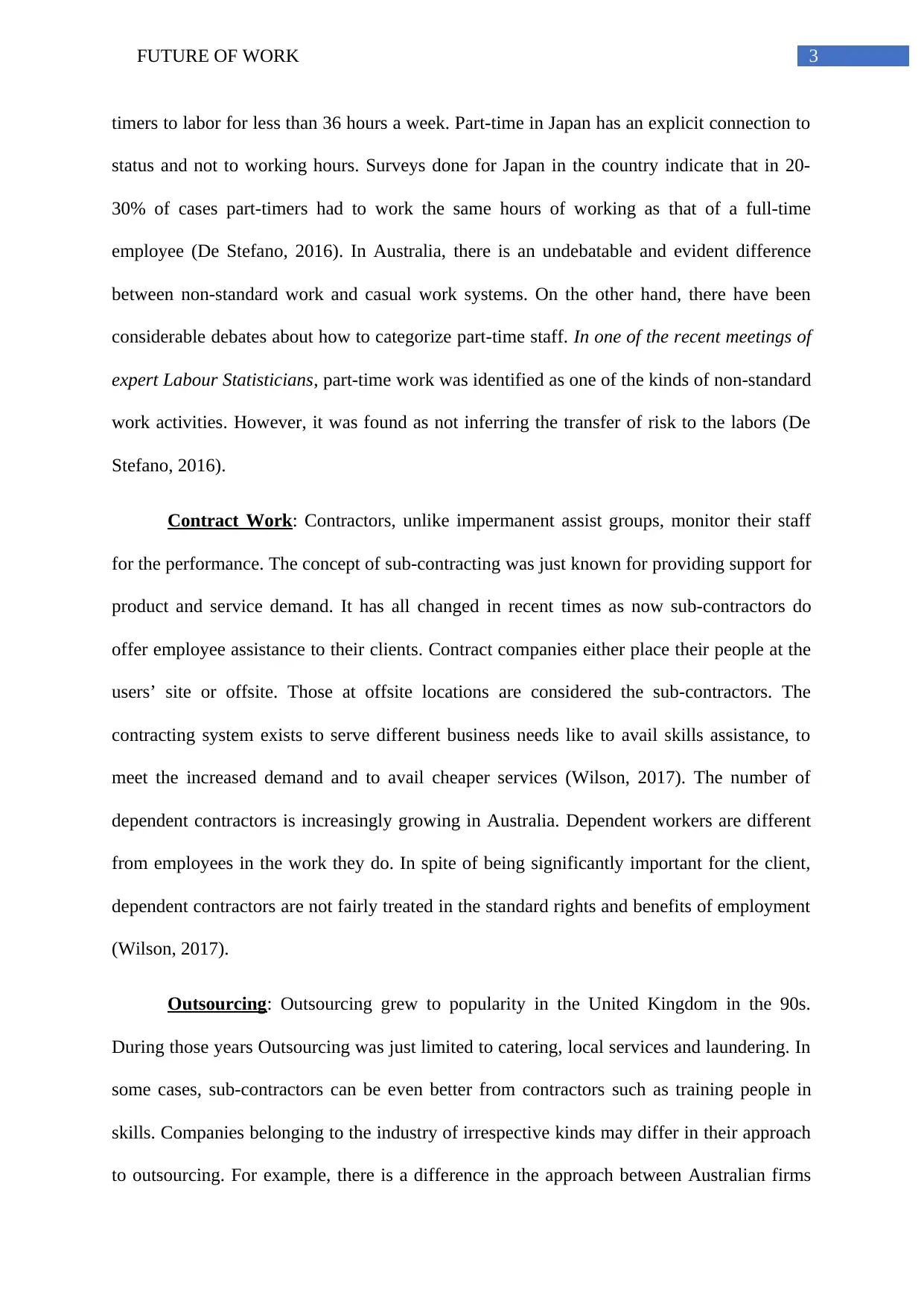
3FUTURE OF WORK
timers to labor for less than 36 hours a week. Part-time in Japan has an explicit connection to
status and not to working hours. Surveys done for Japan in the country indicate that in 20-
30% of cases part-timers had to work the same hours of working as that of a full-time
employee (De Stefano, 2016). In Australia, there is an undebatable and evident difference
between non-standard work and casual work systems. On the other hand, there have been
considerable debates about how to categorize part-time staff. In one of the recent meetings of
expert Labour Statisticians, part-time work was identified as one of the kinds of non-standard
work activities. However, it was found as not inferring the transfer of risk to the labors (De
Stefano, 2016).
Contract Work: Contractors, unlike impermanent assist groups, monitor their staff
for the performance. The concept of sub-contracting was just known for providing support for
product and service demand. It has all changed in recent times as now sub-contractors do
offer employee assistance to their clients. Contract companies either place their people at the
users’ site or offsite. Those at offsite locations are considered the sub-contractors. The
contracting system exists to serve different business needs like to avail skills assistance, to
meet the increased demand and to avail cheaper services (Wilson, 2017). The number of
dependent contractors is increasingly growing in Australia. Dependent workers are different
from employees in the work they do. In spite of being significantly important for the client,
dependent contractors are not fairly treated in the standard rights and benefits of employment
(Wilson, 2017).
Outsourcing: Outsourcing grew to popularity in the United Kingdom in the 90s.
During those years Outsourcing was just limited to catering, local services and laundering. In
some cases, sub-contractors can be even better from contractors such as training people in
skills. Companies belonging to the industry of irrespective kinds may differ in their approach
to outsourcing. For example, there is a difference in the approach between Australian firms
timers to labor for less than 36 hours a week. Part-time in Japan has an explicit connection to
status and not to working hours. Surveys done for Japan in the country indicate that in 20-
30% of cases part-timers had to work the same hours of working as that of a full-time
employee (De Stefano, 2016). In Australia, there is an undebatable and evident difference
between non-standard work and casual work systems. On the other hand, there have been
considerable debates about how to categorize part-time staff. In one of the recent meetings of
expert Labour Statisticians, part-time work was identified as one of the kinds of non-standard
work activities. However, it was found as not inferring the transfer of risk to the labors (De
Stefano, 2016).
Contract Work: Contractors, unlike impermanent assist groups, monitor their staff
for the performance. The concept of sub-contracting was just known for providing support for
product and service demand. It has all changed in recent times as now sub-contractors do
offer employee assistance to their clients. Contract companies either place their people at the
users’ site or offsite. Those at offsite locations are considered the sub-contractors. The
contracting system exists to serve different business needs like to avail skills assistance, to
meet the increased demand and to avail cheaper services (Wilson, 2017). The number of
dependent contractors is increasingly growing in Australia. Dependent workers are different
from employees in the work they do. In spite of being significantly important for the client,
dependent contractors are not fairly treated in the standard rights and benefits of employment
(Wilson, 2017).
Outsourcing: Outsourcing grew to popularity in the United Kingdom in the 90s.
During those years Outsourcing was just limited to catering, local services and laundering. In
some cases, sub-contractors can be even better from contractors such as training people in
skills. Companies belonging to the industry of irrespective kinds may differ in their approach
to outsourcing. For example, there is a difference in the approach between Australian firms
Paraphrase This Document
Need a fresh take? Get an instant paraphrase of this document with our AI Paraphraser
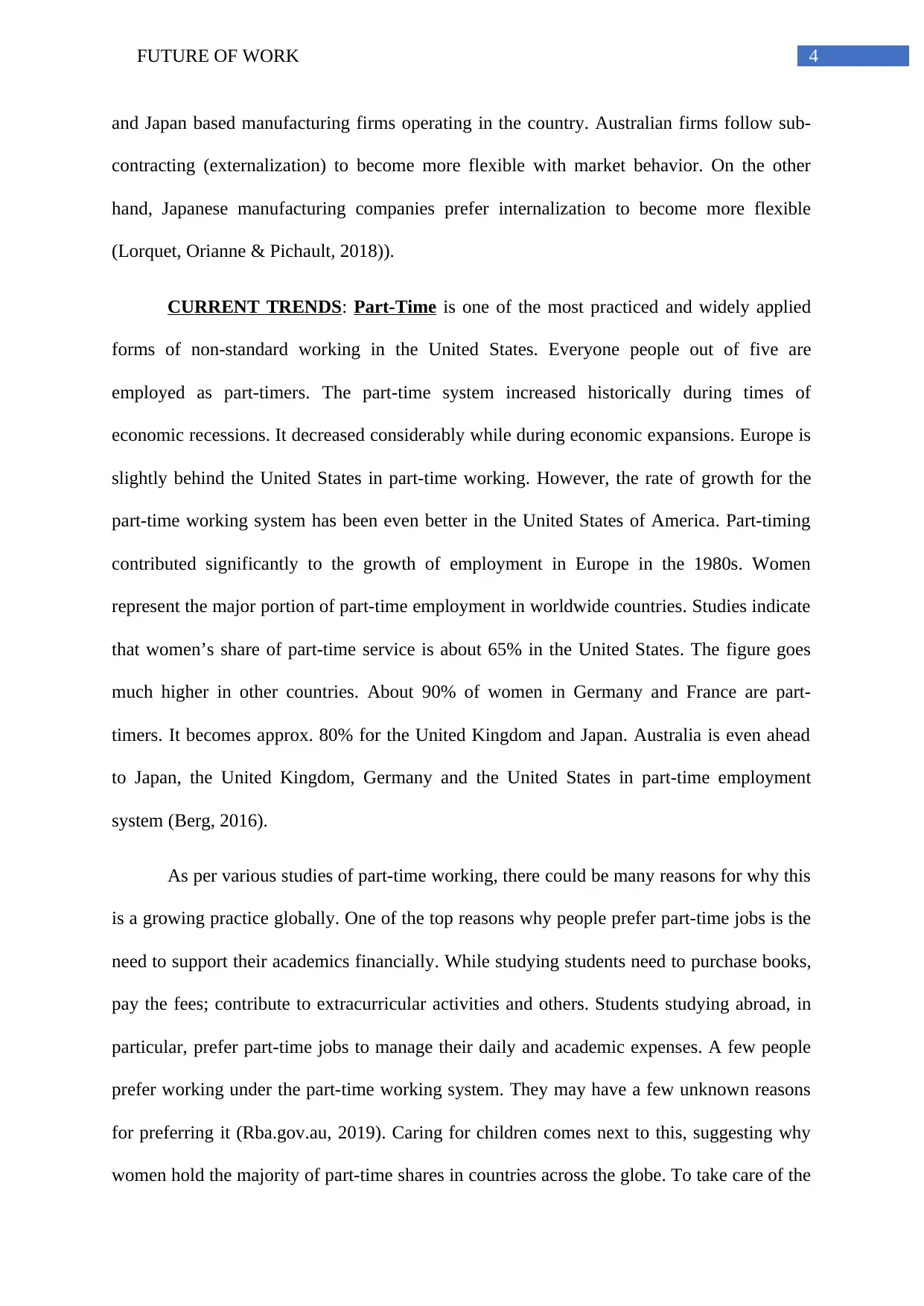
4FUTURE OF WORK
and Japan based manufacturing firms operating in the country. Australian firms follow sub-
contracting (externalization) to become more flexible with market behavior. On the other
hand, Japanese manufacturing companies prefer internalization to become more flexible
(Lorquet, Orianne & Pichault, 2018)).
CURRENT TRENDS: Part-Time is one of the most practiced and widely applied
forms of non-standard working in the United States. Everyone people out of five are
employed as part-timers. The part-time system increased historically during times of
economic recessions. It decreased considerably while during economic expansions. Europe is
slightly behind the United States in part-time working. However, the rate of growth for the
part-time working system has been even better in the United States of America. Part-timing
contributed significantly to the growth of employment in Europe in the 1980s. Women
represent the major portion of part-time employment in worldwide countries. Studies indicate
that women’s share of part-time service is about 65% in the United States. The figure goes
much higher in other countries. About 90% of women in Germany and France are part-
timers. It becomes approx. 80% for the United Kingdom and Japan. Australia is even ahead
to Japan, the United Kingdom, Germany and the United States in part-time employment
system (Berg, 2016).
As per various studies of part-time working, there could be many reasons for why this
is a growing practice globally. One of the top reasons why people prefer part-time jobs is the
need to support their academics financially. While studying students need to purchase books,
pay the fees; contribute to extracurricular activities and others. Students studying abroad, in
particular, prefer part-time jobs to manage their daily and academic expenses. A few people
prefer working under the part-time working system. They may have a few unknown reasons
for preferring it (Rba.gov.au, 2019). Caring for children comes next to this, suggesting why
women hold the majority of part-time shares in countries across the globe. To take care of the
and Japan based manufacturing firms operating in the country. Australian firms follow sub-
contracting (externalization) to become more flexible with market behavior. On the other
hand, Japanese manufacturing companies prefer internalization to become more flexible
(Lorquet, Orianne & Pichault, 2018)).
CURRENT TRENDS: Part-Time is one of the most practiced and widely applied
forms of non-standard working in the United States. Everyone people out of five are
employed as part-timers. The part-time system increased historically during times of
economic recessions. It decreased considerably while during economic expansions. Europe is
slightly behind the United States in part-time working. However, the rate of growth for the
part-time working system has been even better in the United States of America. Part-timing
contributed significantly to the growth of employment in Europe in the 1980s. Women
represent the major portion of part-time employment in worldwide countries. Studies indicate
that women’s share of part-time service is about 65% in the United States. The figure goes
much higher in other countries. About 90% of women in Germany and France are part-
timers. It becomes approx. 80% for the United Kingdom and Japan. Australia is even ahead
to Japan, the United Kingdom, Germany and the United States in part-time employment
system (Berg, 2016).
As per various studies of part-time working, there could be many reasons for why this
is a growing practice globally. One of the top reasons why people prefer part-time jobs is the
need to support their academics financially. While studying students need to purchase books,
pay the fees; contribute to extracurricular activities and others. Students studying abroad, in
particular, prefer part-time jobs to manage their daily and academic expenses. A few people
prefer working under the part-time working system. They may have a few unknown reasons
for preferring it (Rba.gov.au, 2019). Caring for children comes next to this, suggesting why
women hold the majority of part-time shares in countries across the globe. To take care of the
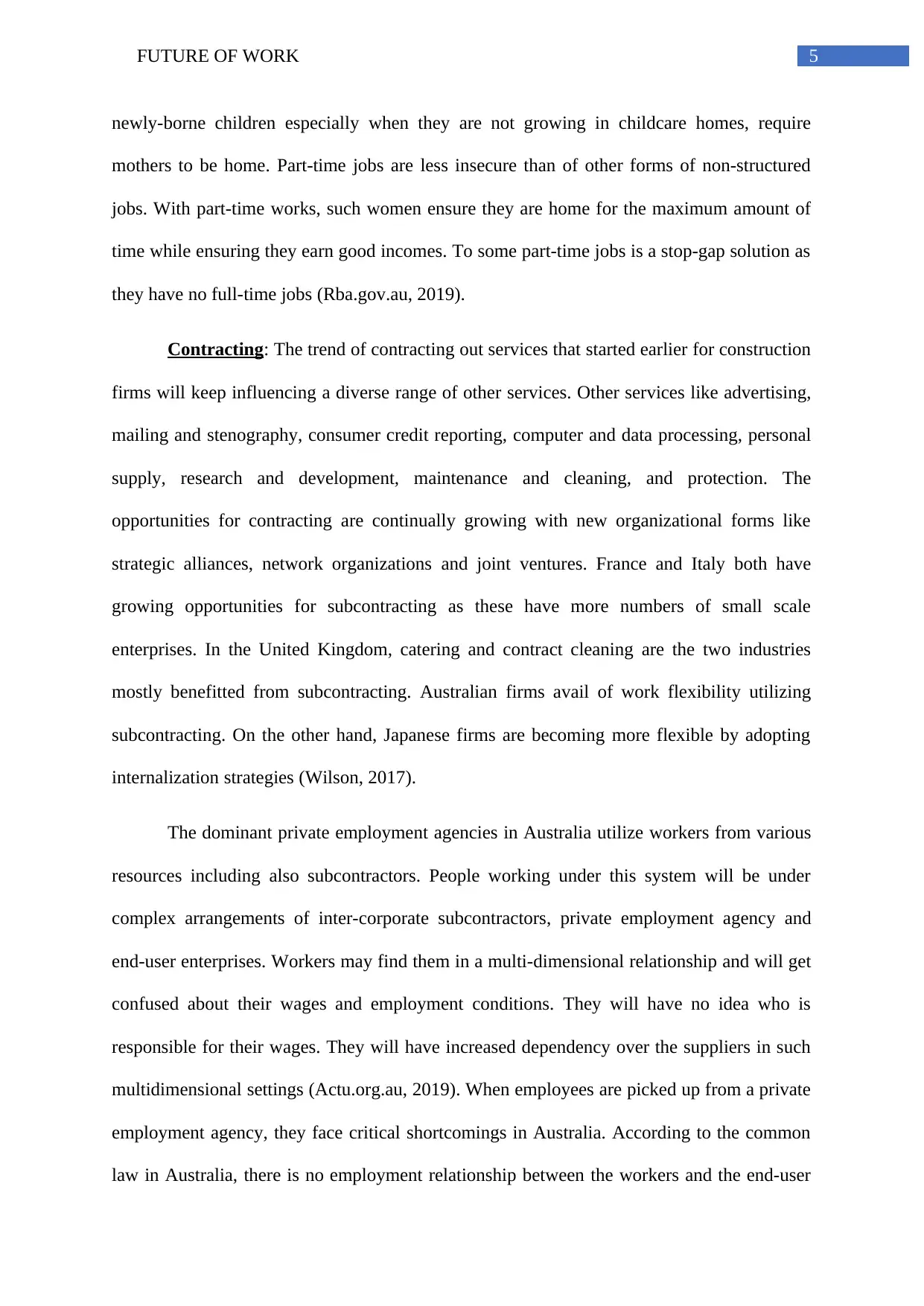
5FUTURE OF WORK
newly-borne children especially when they are not growing in childcare homes, require
mothers to be home. Part-time jobs are less insecure than of other forms of non-structured
jobs. With part-time works, such women ensure they are home for the maximum amount of
time while ensuring they earn good incomes. To some part-time jobs is a stop-gap solution as
they have no full-time jobs (Rba.gov.au, 2019).
Contracting: The trend of contracting out services that started earlier for construction
firms will keep influencing a diverse range of other services. Other services like advertising,
mailing and stenography, consumer credit reporting, computer and data processing, personal
supply, research and development, maintenance and cleaning, and protection. The
opportunities for contracting are continually growing with new organizational forms like
strategic alliances, network organizations and joint ventures. France and Italy both have
growing opportunities for subcontracting as these have more numbers of small scale
enterprises. In the United Kingdom, catering and contract cleaning are the two industries
mostly benefitted from subcontracting. Australian firms avail of work flexibility utilizing
subcontracting. On the other hand, Japanese firms are becoming more flexible by adopting
internalization strategies (Wilson, 2017).
The dominant private employment agencies in Australia utilize workers from various
resources including also subcontractors. People working under this system will be under
complex arrangements of inter-corporate subcontractors, private employment agency and
end-user enterprises. Workers may find them in a multi-dimensional relationship and will get
confused about their wages and employment conditions. They will have no idea who is
responsible for their wages. They will have increased dependency over the suppliers in such
multidimensional settings (Actu.org.au, 2019). When employees are picked up from a private
employment agency, they face critical shortcomings in Australia. According to the common
law in Australia, there is no employment relationship between the workers and the end-user
newly-borne children especially when they are not growing in childcare homes, require
mothers to be home. Part-time jobs are less insecure than of other forms of non-structured
jobs. With part-time works, such women ensure they are home for the maximum amount of
time while ensuring they earn good incomes. To some part-time jobs is a stop-gap solution as
they have no full-time jobs (Rba.gov.au, 2019).
Contracting: The trend of contracting out services that started earlier for construction
firms will keep influencing a diverse range of other services. Other services like advertising,
mailing and stenography, consumer credit reporting, computer and data processing, personal
supply, research and development, maintenance and cleaning, and protection. The
opportunities for contracting are continually growing with new organizational forms like
strategic alliances, network organizations and joint ventures. France and Italy both have
growing opportunities for subcontracting as these have more numbers of small scale
enterprises. In the United Kingdom, catering and contract cleaning are the two industries
mostly benefitted from subcontracting. Australian firms avail of work flexibility utilizing
subcontracting. On the other hand, Japanese firms are becoming more flexible by adopting
internalization strategies (Wilson, 2017).
The dominant private employment agencies in Australia utilize workers from various
resources including also subcontractors. People working under this system will be under
complex arrangements of inter-corporate subcontractors, private employment agency and
end-user enterprises. Workers may find them in a multi-dimensional relationship and will get
confused about their wages and employment conditions. They will have no idea who is
responsible for their wages. They will have increased dependency over the suppliers in such
multidimensional settings (Actu.org.au, 2019). When employees are picked up from a private
employment agency, they face critical shortcomings in Australia. According to the common
law in Australia, there is no employment relationship between the workers and the end-user
⊘ This is a preview!⊘
Do you want full access?
Subscribe today to unlock all pages.

Trusted by 1+ million students worldwide
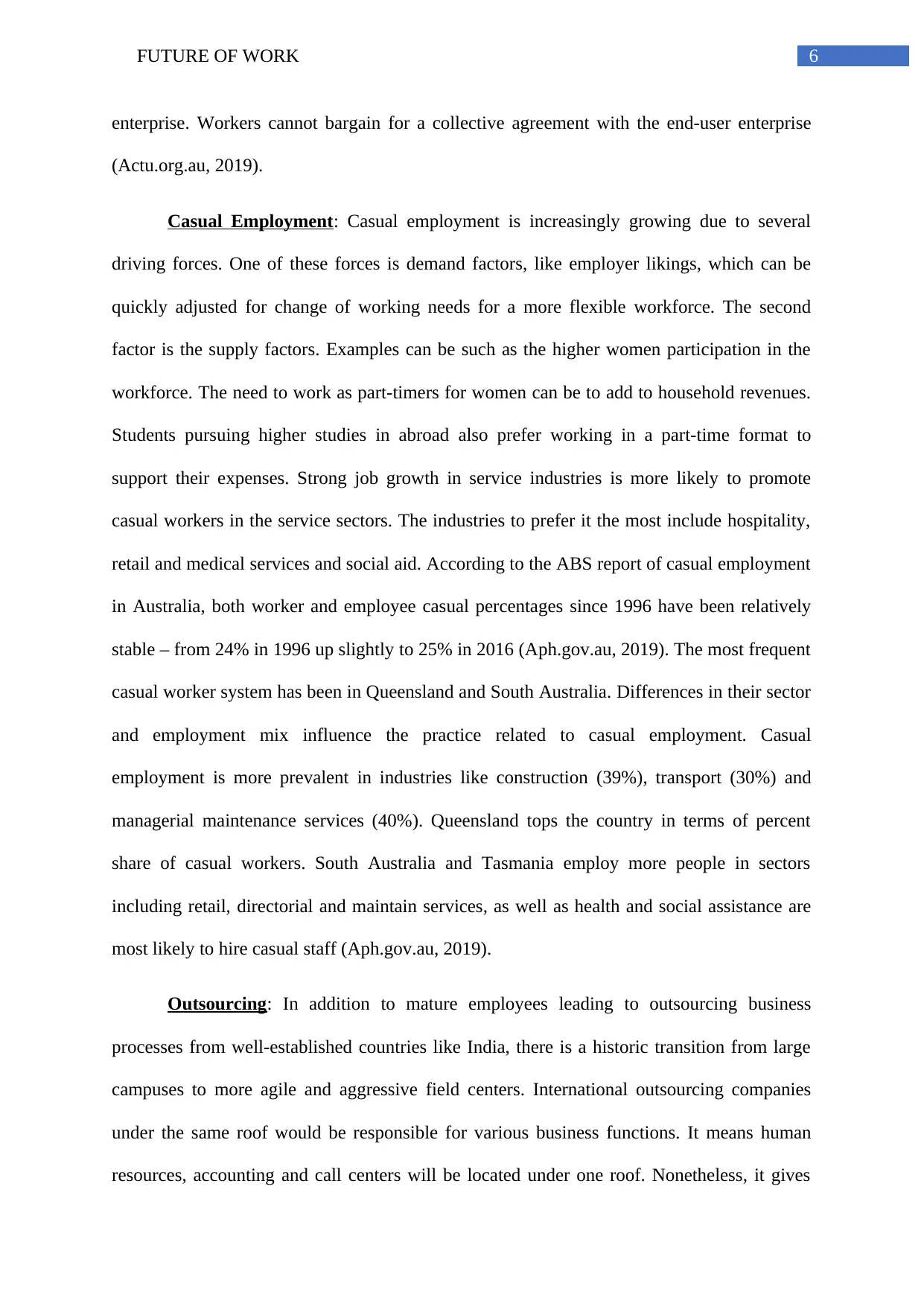
6FUTURE OF WORK
enterprise. Workers cannot bargain for a collective agreement with the end-user enterprise
(Actu.org.au, 2019).
Casual Employment: Casual employment is increasingly growing due to several
driving forces. One of these forces is demand factors, like employer likings, which can be
quickly adjusted for change of working needs for a more flexible workforce. The second
factor is the supply factors. Examples can be such as the higher women participation in the
workforce. The need to work as part-timers for women can be to add to household revenues.
Students pursuing higher studies in abroad also prefer working in a part-time format to
support their expenses. Strong job growth in service industries is more likely to promote
casual workers in the service sectors. The industries to prefer it the most include hospitality,
retail and medical services and social aid. According to the ABS report of casual employment
in Australia, both worker and employee casual percentages since 1996 have been relatively
stable – from 24% in 1996 up slightly to 25% in 2016 (Aph.gov.au, 2019). The most frequent
casual worker system has been in Queensland and South Australia. Differences in their sector
and employment mix influence the practice related to casual employment. Casual
employment is more prevalent in industries like construction (39%), transport (30%) and
managerial maintenance services (40%). Queensland tops the country in terms of percent
share of casual workers. South Australia and Tasmania employ more people in sectors
including retail, directorial and maintain services, as well as health and social assistance are
most likely to hire casual staff (Aph.gov.au, 2019).
Outsourcing: In addition to mature employees leading to outsourcing business
processes from well-established countries like India, there is a historic transition from large
campuses to more agile and aggressive field centers. International outsourcing companies
under the same roof would be responsible for various business functions. It means human
resources, accounting and call centers will be located under one roof. Nonetheless, it gives
enterprise. Workers cannot bargain for a collective agreement with the end-user enterprise
(Actu.org.au, 2019).
Casual Employment: Casual employment is increasingly growing due to several
driving forces. One of these forces is demand factors, like employer likings, which can be
quickly adjusted for change of working needs for a more flexible workforce. The second
factor is the supply factors. Examples can be such as the higher women participation in the
workforce. The need to work as part-timers for women can be to add to household revenues.
Students pursuing higher studies in abroad also prefer working in a part-time format to
support their expenses. Strong job growth in service industries is more likely to promote
casual workers in the service sectors. The industries to prefer it the most include hospitality,
retail and medical services and social aid. According to the ABS report of casual employment
in Australia, both worker and employee casual percentages since 1996 have been relatively
stable – from 24% in 1996 up slightly to 25% in 2016 (Aph.gov.au, 2019). The most frequent
casual worker system has been in Queensland and South Australia. Differences in their sector
and employment mix influence the practice related to casual employment. Casual
employment is more prevalent in industries like construction (39%), transport (30%) and
managerial maintenance services (40%). Queensland tops the country in terms of percent
share of casual workers. South Australia and Tasmania employ more people in sectors
including retail, directorial and maintain services, as well as health and social assistance are
most likely to hire casual staff (Aph.gov.au, 2019).
Outsourcing: In addition to mature employees leading to outsourcing business
processes from well-established countries like India, there is a historic transition from large
campuses to more agile and aggressive field centers. International outsourcing companies
under the same roof would be responsible for various business functions. It means human
resources, accounting and call centers will be located under one roof. Nonetheless, it gives
Paraphrase This Document
Need a fresh take? Get an instant paraphrase of this document with our AI Paraphraser
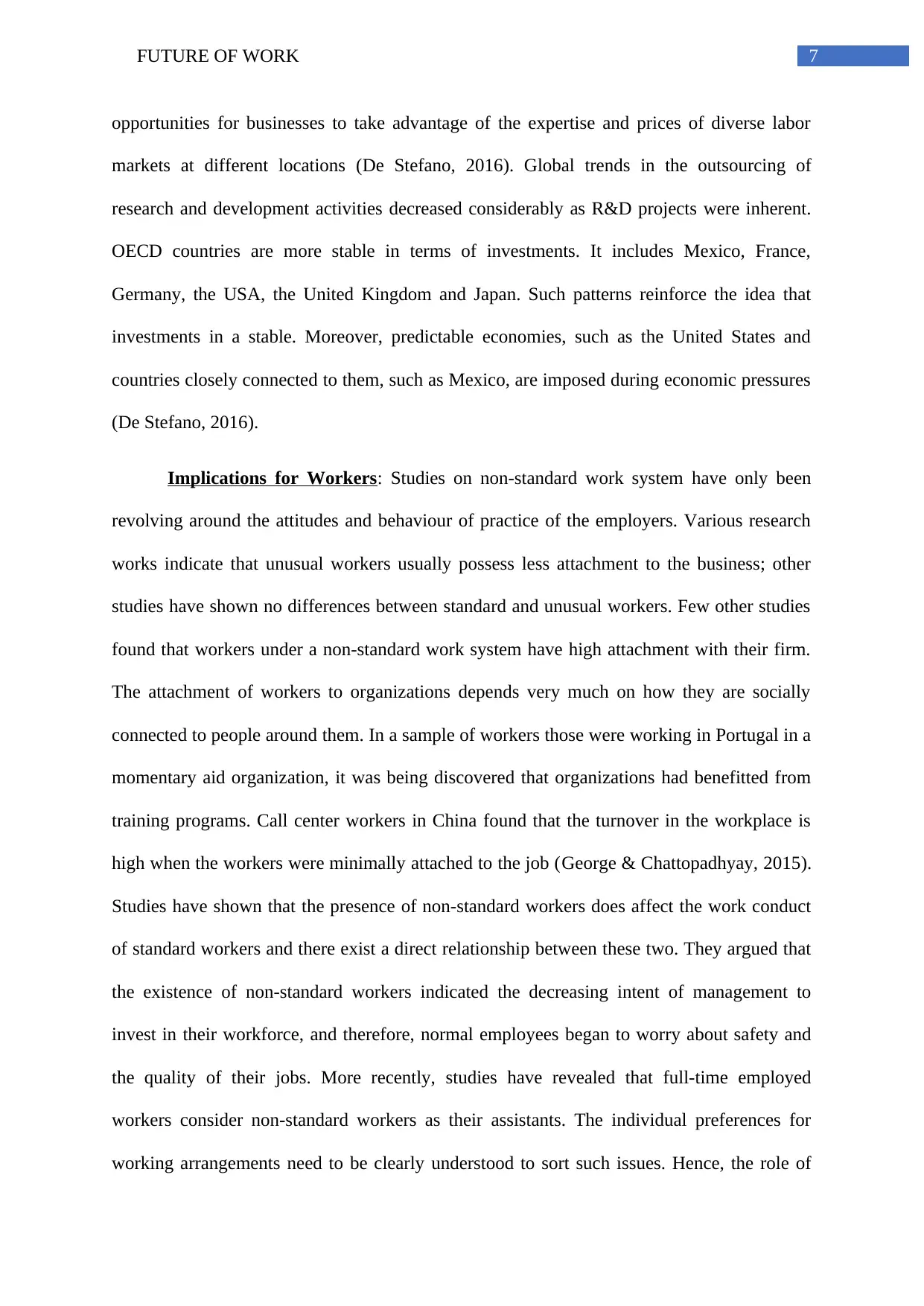
7FUTURE OF WORK
opportunities for businesses to take advantage of the expertise and prices of diverse labor
markets at different locations (De Stefano, 2016). Global trends in the outsourcing of
research and development activities decreased considerably as R&D projects were inherent.
OECD countries are more stable in terms of investments. It includes Mexico, France,
Germany, the USA, the United Kingdom and Japan. Such patterns reinforce the idea that
investments in a stable. Moreover, predictable economies, such as the United States and
countries closely connected to them, such as Mexico, are imposed during economic pressures
(De Stefano, 2016).
Implications for Workers: Studies on non-standard work system have only been
revolving around the attitudes and behaviour of practice of the employers. Various research
works indicate that unusual workers usually possess less attachment to the business; other
studies have shown no differences between standard and unusual workers. Few other studies
found that workers under a non-standard work system have high attachment with their firm.
The attachment of workers to organizations depends very much on how they are socially
connected to people around them. In a sample of workers those were working in Portugal in a
momentary aid organization, it was being discovered that organizations had benefitted from
training programs. Call center workers in China found that the turnover in the workplace is
high when the workers were minimally attached to the job (George & Chattopadhyay, 2015).
Studies have shown that the presence of non-standard workers does affect the work conduct
of standard workers and there exist a direct relationship between these two. They argued that
the existence of non-standard workers indicated the decreasing intent of management to
invest in their workforce, and therefore, normal employees began to worry about safety and
the quality of their jobs. More recently, studies have revealed that full-time employed
workers consider non-standard workers as their assistants. The individual preferences for
working arrangements need to be clearly understood to sort such issues. Hence, the role of
opportunities for businesses to take advantage of the expertise and prices of diverse labor
markets at different locations (De Stefano, 2016). Global trends in the outsourcing of
research and development activities decreased considerably as R&D projects were inherent.
OECD countries are more stable in terms of investments. It includes Mexico, France,
Germany, the USA, the United Kingdom and Japan. Such patterns reinforce the idea that
investments in a stable. Moreover, predictable economies, such as the United States and
countries closely connected to them, such as Mexico, are imposed during economic pressures
(De Stefano, 2016).
Implications for Workers: Studies on non-standard work system have only been
revolving around the attitudes and behaviour of practice of the employers. Various research
works indicate that unusual workers usually possess less attachment to the business; other
studies have shown no differences between standard and unusual workers. Few other studies
found that workers under a non-standard work system have high attachment with their firm.
The attachment of workers to organizations depends very much on how they are socially
connected to people around them. In a sample of workers those were working in Portugal in a
momentary aid organization, it was being discovered that organizations had benefitted from
training programs. Call center workers in China found that the turnover in the workplace is
high when the workers were minimally attached to the job (George & Chattopadhyay, 2015).
Studies have shown that the presence of non-standard workers does affect the work conduct
of standard workers and there exist a direct relationship between these two. They argued that
the existence of non-standard workers indicated the decreasing intent of management to
invest in their workforce, and therefore, normal employees began to worry about safety and
the quality of their jobs. More recently, studies have revealed that full-time employed
workers consider non-standard workers as their assistants. The individual preferences for
working arrangements need to be clearly understood to sort such issues. Hence, the role of
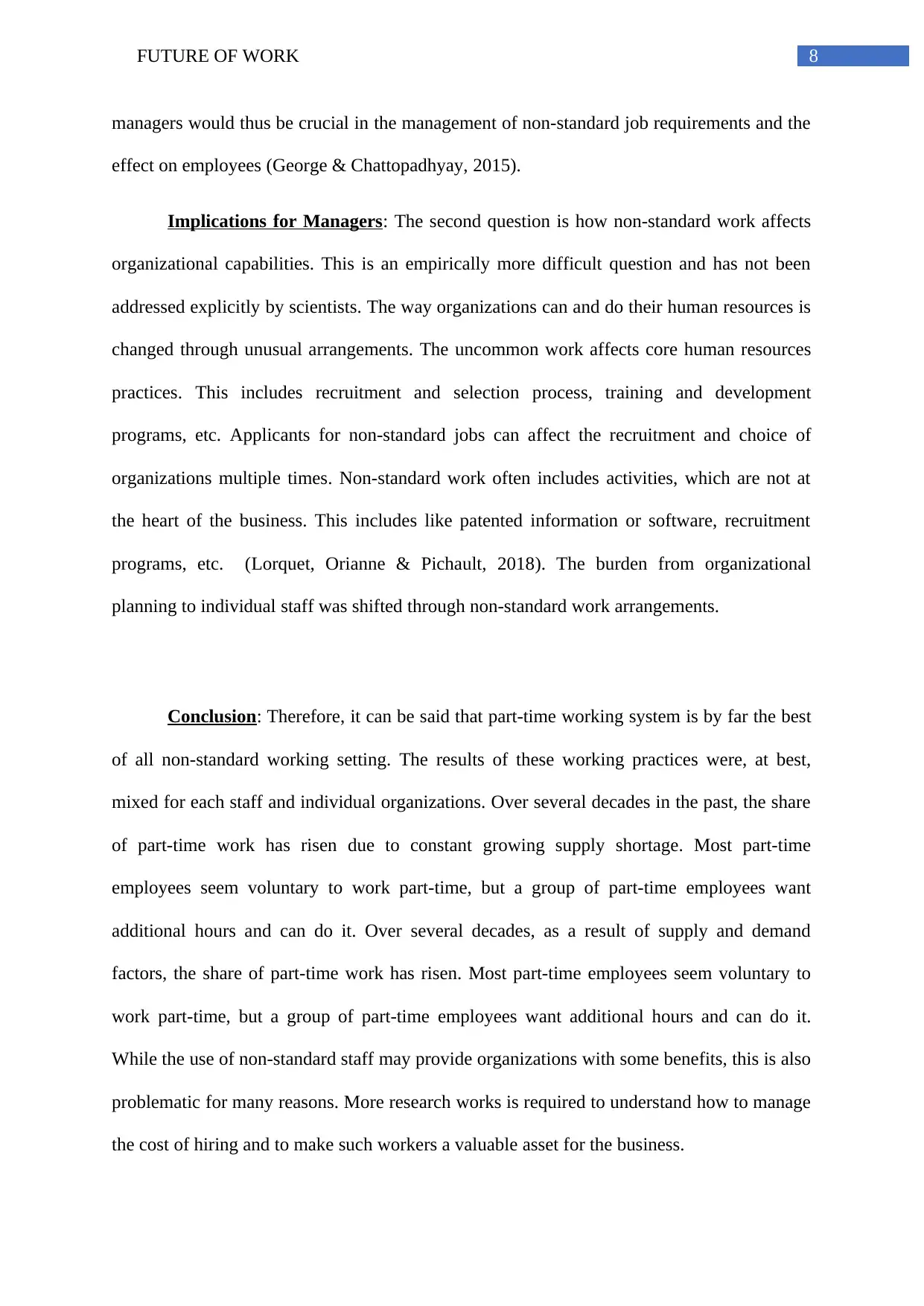
8FUTURE OF WORK
managers would thus be crucial in the management of non-standard job requirements and the
effect on employees (George & Chattopadhyay, 2015).
Implications for Managers: The second question is how non-standard work affects
organizational capabilities. This is an empirically more difficult question and has not been
addressed explicitly by scientists. The way organizations can and do their human resources is
changed through unusual arrangements. The uncommon work affects core human resources
practices. This includes recruitment and selection process, training and development
programs, etc. Applicants for non-standard jobs can affect the recruitment and choice of
organizations multiple times. Non-standard work often includes activities, which are not at
the heart of the business. This includes like patented information or software, recruitment
programs, etc. (Lorquet, Orianne & Pichault, 2018). The burden from organizational
planning to individual staff was shifted through non-standard work arrangements.
Conclusion: Therefore, it can be said that part-time working system is by far the best
of all non-standard working setting. The results of these working practices were, at best,
mixed for each staff and individual organizations. Over several decades in the past, the share
of part-time work has risen due to constant growing supply shortage. Most part-time
employees seem voluntary to work part-time, but a group of part-time employees want
additional hours and can do it. Over several decades, as a result of supply and demand
factors, the share of part-time work has risen. Most part-time employees seem voluntary to
work part-time, but a group of part-time employees want additional hours and can do it.
While the use of non-standard staff may provide organizations with some benefits, this is also
problematic for many reasons. More research works is required to understand how to manage
the cost of hiring and to make such workers a valuable asset for the business.
managers would thus be crucial in the management of non-standard job requirements and the
effect on employees (George & Chattopadhyay, 2015).
Implications for Managers: The second question is how non-standard work affects
organizational capabilities. This is an empirically more difficult question and has not been
addressed explicitly by scientists. The way organizations can and do their human resources is
changed through unusual arrangements. The uncommon work affects core human resources
practices. This includes recruitment and selection process, training and development
programs, etc. Applicants for non-standard jobs can affect the recruitment and choice of
organizations multiple times. Non-standard work often includes activities, which are not at
the heart of the business. This includes like patented information or software, recruitment
programs, etc. (Lorquet, Orianne & Pichault, 2018). The burden from organizational
planning to individual staff was shifted through non-standard work arrangements.
Conclusion: Therefore, it can be said that part-time working system is by far the best
of all non-standard working setting. The results of these working practices were, at best,
mixed for each staff and individual organizations. Over several decades in the past, the share
of part-time work has risen due to constant growing supply shortage. Most part-time
employees seem voluntary to work part-time, but a group of part-time employees want
additional hours and can do it. Over several decades, as a result of supply and demand
factors, the share of part-time work has risen. Most part-time employees seem voluntary to
work part-time, but a group of part-time employees want additional hours and can do it.
While the use of non-standard staff may provide organizations with some benefits, this is also
problematic for many reasons. More research works is required to understand how to manage
the cost of hiring and to make such workers a valuable asset for the business.
⊘ This is a preview!⊘
Do you want full access?
Subscribe today to unlock all pages.

Trusted by 1+ million students worldwide
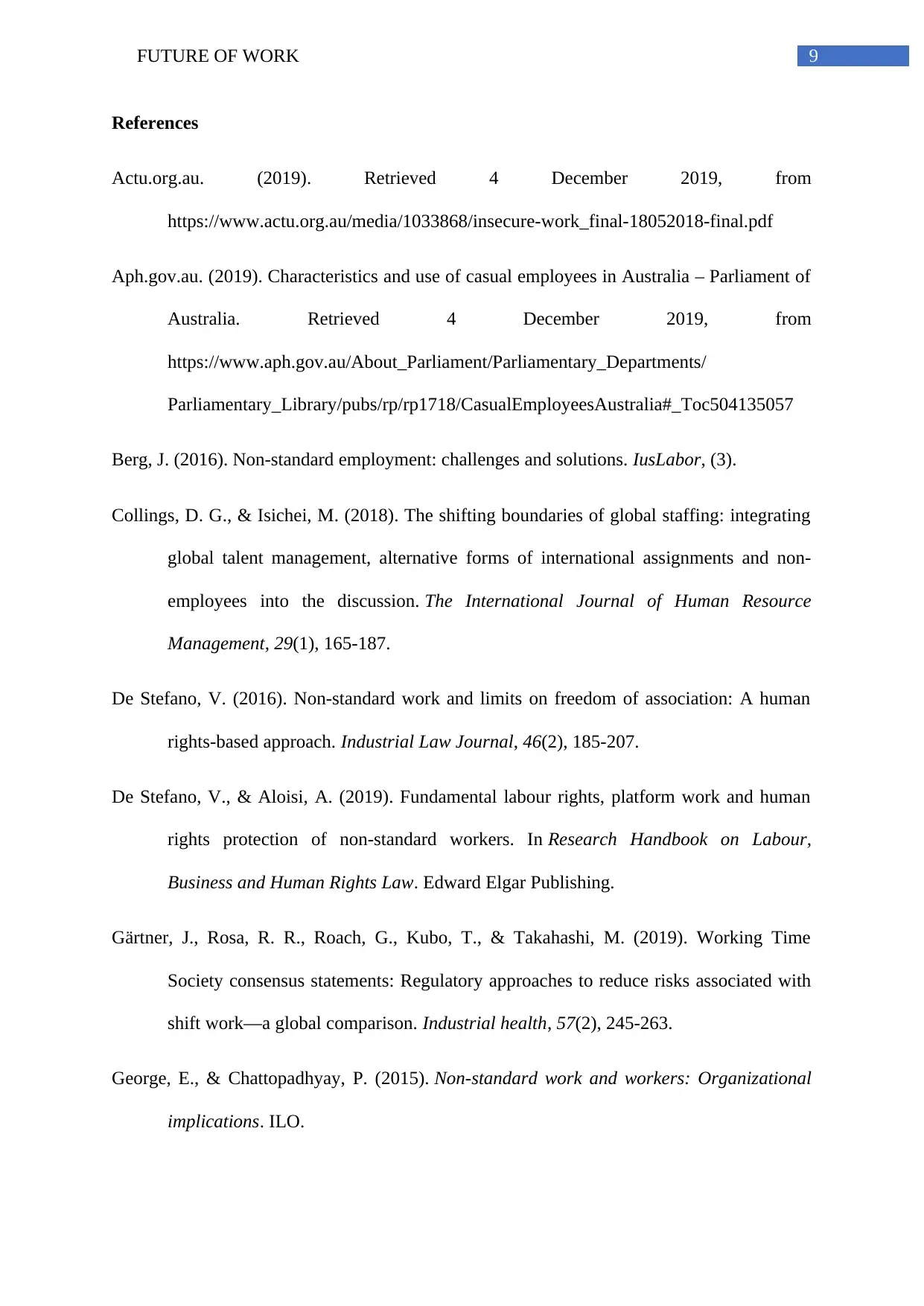
9FUTURE OF WORK
References
Actu.org.au. (2019). Retrieved 4 December 2019, from
https://www.actu.org.au/media/1033868/insecure-work_final-18052018-final.pdf
Aph.gov.au. (2019). Characteristics and use of casual employees in Australia – Parliament of
Australia. Retrieved 4 December 2019, from
https://www.aph.gov.au/About_Parliament/Parliamentary_Departments/
Parliamentary_Library/pubs/rp/rp1718/CasualEmployeesAustralia#_Toc504135057
Berg, J. (2016). Non-standard employment: challenges and solutions. IusLabor, (3).
Collings, D. G., & Isichei, M. (2018). The shifting boundaries of global staffing: integrating
global talent management, alternative forms of international assignments and non-
employees into the discussion. The International Journal of Human Resource
Management, 29(1), 165-187.
De Stefano, V. (2016). Non-standard work and limits on freedom of association: A human
rights-based approach. Industrial Law Journal, 46(2), 185-207.
De Stefano, V., & Aloisi, A. (2019). Fundamental labour rights, platform work and human
rights protection of non-standard workers. In Research Handbook on Labour,
Business and Human Rights Law. Edward Elgar Publishing.
Gärtner, J., Rosa, R. R., Roach, G., Kubo, T., & Takahashi, M. (2019). Working Time
Society consensus statements: Regulatory approaches to reduce risks associated with
shift work—a global comparison. Industrial health, 57(2), 245-263.
George, E., & Chattopadhyay, P. (2015). Non-standard work and workers: Organizational
implications. ILO.
References
Actu.org.au. (2019). Retrieved 4 December 2019, from
https://www.actu.org.au/media/1033868/insecure-work_final-18052018-final.pdf
Aph.gov.au. (2019). Characteristics and use of casual employees in Australia – Parliament of
Australia. Retrieved 4 December 2019, from
https://www.aph.gov.au/About_Parliament/Parliamentary_Departments/
Parliamentary_Library/pubs/rp/rp1718/CasualEmployeesAustralia#_Toc504135057
Berg, J. (2016). Non-standard employment: challenges and solutions. IusLabor, (3).
Collings, D. G., & Isichei, M. (2018). The shifting boundaries of global staffing: integrating
global talent management, alternative forms of international assignments and non-
employees into the discussion. The International Journal of Human Resource
Management, 29(1), 165-187.
De Stefano, V. (2016). Non-standard work and limits on freedom of association: A human
rights-based approach. Industrial Law Journal, 46(2), 185-207.
De Stefano, V., & Aloisi, A. (2019). Fundamental labour rights, platform work and human
rights protection of non-standard workers. In Research Handbook on Labour,
Business and Human Rights Law. Edward Elgar Publishing.
Gärtner, J., Rosa, R. R., Roach, G., Kubo, T., & Takahashi, M. (2019). Working Time
Society consensus statements: Regulatory approaches to reduce risks associated with
shift work—a global comparison. Industrial health, 57(2), 245-263.
George, E., & Chattopadhyay, P. (2015). Non-standard work and workers: Organizational
implications. ILO.
Paraphrase This Document
Need a fresh take? Get an instant paraphrase of this document with our AI Paraphraser
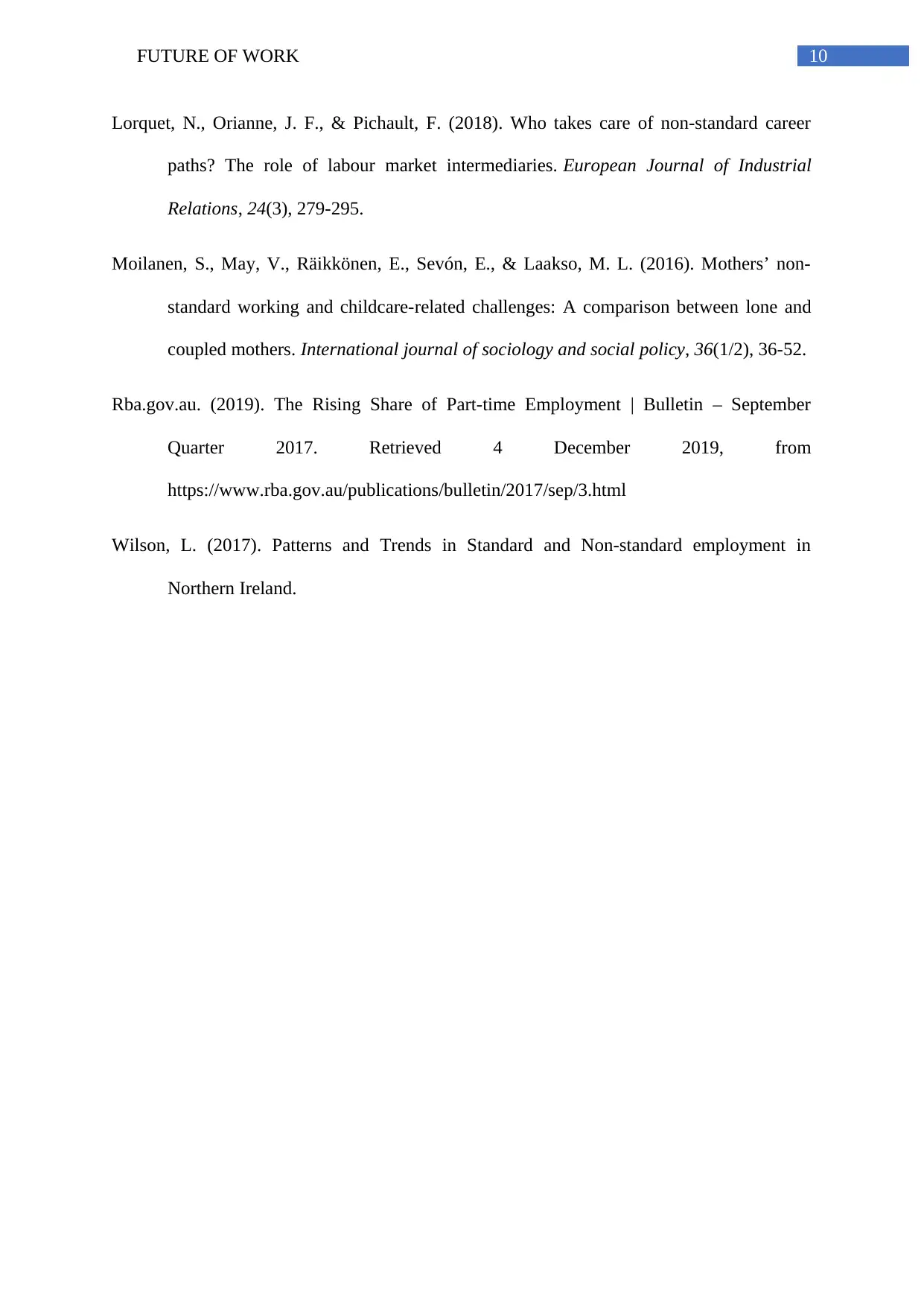
10FUTURE OF WORK
Lorquet, N., Orianne, J. F., & Pichault, F. (2018). Who takes care of non-standard career
paths? The role of labour market intermediaries. European Journal of Industrial
Relations, 24(3), 279-295.
Moilanen, S., May, V., Räikkönen, E., Sevón, E., & Laakso, M. L. (2016). Mothers’ non-
standard working and childcare-related challenges: A comparison between lone and
coupled mothers. International journal of sociology and social policy, 36(1/2), 36-52.
Rba.gov.au. (2019). The Rising Share of Part-time Employment | Bulletin – September
Quarter 2017. Retrieved 4 December 2019, from
https://www.rba.gov.au/publications/bulletin/2017/sep/3.html
Wilson, L. (2017). Patterns and Trends in Standard and Non-standard employment in
Northern Ireland.
Lorquet, N., Orianne, J. F., & Pichault, F. (2018). Who takes care of non-standard career
paths? The role of labour market intermediaries. European Journal of Industrial
Relations, 24(3), 279-295.
Moilanen, S., May, V., Räikkönen, E., Sevón, E., & Laakso, M. L. (2016). Mothers’ non-
standard working and childcare-related challenges: A comparison between lone and
coupled mothers. International journal of sociology and social policy, 36(1/2), 36-52.
Rba.gov.au. (2019). The Rising Share of Part-time Employment | Bulletin – September
Quarter 2017. Retrieved 4 December 2019, from
https://www.rba.gov.au/publications/bulletin/2017/sep/3.html
Wilson, L. (2017). Patterns and Trends in Standard and Non-standard employment in
Northern Ireland.
1 out of 11
Related Documents
Your All-in-One AI-Powered Toolkit for Academic Success.
+13062052269
info@desklib.com
Available 24*7 on WhatsApp / Email
![[object Object]](/_next/static/media/star-bottom.7253800d.svg)
Unlock your academic potential
Copyright © 2020–2025 A2Z Services. All Rights Reserved. Developed and managed by ZUCOL.





